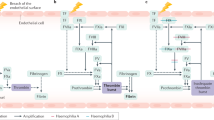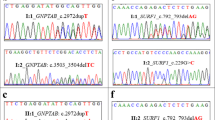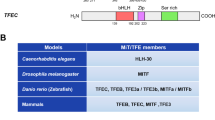Abstract
Haemophilia B Leyden is characterized by low childhood levels of factor IX which gradually increase after puberty, eventually resulting in a return to health. The disease is the result of single nucleotide substitutions within a 40 bp region encompassing the major transcriptional start site. We have characterized transcription factor binding sites within the factor IX promoter. Five sites were identified and a Leyden mutation at nucleotide −5 was shown to interfere with the binding of proteins to one of three newly identified sites. The correlation between the post–pubertal recovery of these mutants and the induction of the transcription factor DBP led us to the discovery of a synergistic interaction between DBP and C/EBP responsible for the recovery of normal transcriptional activity of the −5 mutant promoter and may play a role in the resolution of other Leyden mutants.
This is a preview of subscription content, access via your institution
Access options
Subscribe to this journal
Receive 12 print issues and online access
$259.00 per year
only $21.58 per issue
Buy this article
- Purchase on SpringerLink
- Instant access to full article PDF
Prices may be subject to local taxes which are calculated during checkout
Similar content being viewed by others
References
Giannelli, F. et al. Haemophilia B: Database of point mutations and short additions and deletions. Nucl. Acids Res. 19, 2193–2219 (1991).
Hedner, U. & Davie, E.W. Hemostasis and Thrombosis: Basic Principles and Clinical Practice (eds Colman, R.W., Hirsh, J., Marder, V.J. & Salzman, E.W.) 39–47 (J.P. Lippincott, Philadelphia, 1987).
Briet, E., Bertina, R.M., Van Tilburg, N.H. & Veltkamp, J.J. Hemophilia B Leyden: A sex linked hereditary disorder that improves after puberty. New Engl. J. Med. 306, 788–782 (1982).
Reitsma, P.H., Bertina, R.M., Ploos Van Amstel, J.K., Riemans, A. & Briet, E. The putative factor IX gene promotor in hemophilia B Leyden. Blood 72, 1074–1076 (1988).
Reitsma, P.H., Mandalaki, T., Kasper, C.K., Bertina, R.M. & Briet, E. Two novel point mutations correlate with an altered developmental expression of blood coagulation factor IX (hemophilia B Leyden phenotype). Blood 73, 743–746 (1989).
Hirosawa, S. et al. Structural and functional basis of the developmental regulation of human coagulation factor IX gene: Factor IX Leyden. Proc. natn. Acad. Sci. U.S.A. 87, 4421–4425 (1990).
Freedenberg, D.L. & Black, B. Altered developmental control of the factor IX gene: A new T to A mutation at position +6 of the FIX gene resulting in hemophilia B Leyden. Thromb. Haemost. 65, 964 (1991).
Royle, G., Van De Water, N.S., Berry, E., Ockelford, P.A. & Browett, P.J. Haemophilia B Leyden arising de novo by point mutation in the putative factor IX promoter region. Br. J. Haematol. 77, 191–194 (1991).
Picketts, D.J., D'Souza, C., Bridge, P.J. & Lillicrap, D. An A to T transversion at position −5 of the factor IX promoter results in hemophilia B. Genomics 12, 161–163 (1992).
Crossley, M., Winship, P.R., Austen, D.E.G., Rizza, C.R. & Brownlee, G.G. A less severe form of Haemophilia B Leyden. Nucl. Acids Res. 18, 4633 (1990).
Crossley, M. & Brownlee, G.G. Disruption of a C/EBP binding site in the factor IX promoter is associated with haemophilia B. Nature 345, 444–446 (1990).
Crossley, M. et al. Recovery from hemophilia B Leyden: An androgen-responsive element in the factor IX promoter. Science 257, 377–379 (1992).
Mueller, C.R., Maire, P. & Schibler, U. DBP, a liver-enriched transcriptional activator, is expressed late in ontogeny and its tissue specificity is determined posttranslationally. Cell 61, 279–291 (1990).
Anson, D.S. et al. The gene stucture of human anti-haemophilic factor IX. EMBO J. 3, 1053–1060 (1984).
Salier, J.-P., Hirosawa, S. & Kurachi, K. Functional characterization of the 5′-regulatory region of human factor IX gene. J. biol. Chem. 265, 7062–7068 (1990).
Huang, M.-N., Smith, K., Evans, J.P., Wolde, S.T. & High, K.A. Factor IX expression in the HepG2 cell line. Thromb. Haemostasis 62, 81–84 (1989).
Babiss, L.E., Herbst, R.S., Bennett, A.L. & Darnell Jr, J.E. Factors that interact with the rat albumin promoter are present both in hepatocytes and other cell types. Genes Dev. 1, 256–267 (1987).
Birkenheimer, E.H. et al. Tissue-specific expression, developmental regulation and genetic mapping of the gene encoding CCAAT/enhancer binding protein. Genes Dev. 3, 1146–1156 (1989).
Descombes, P., Chojkier, M., Lichtsteiner, S., Falvey, E. & Schibler, U. LAP, a novel member of the C/EBP gene family, encodes a liver enriched transcriptional activator protein. Genes Dev. 4, 1541–1551 (1990).
Graves, B.J., Johnson, P.F. & McKnight, S.L. Homologous recognition of a promoter domain common to the MSV LTR and the HSV tk gene. Cell 44, 565–576 (1986).
Jones, K.A., Yamamoto, K.R. & Tjian, R. Two distinct transcription factors bind to the HSV thymidine kinase promoter in vitro. Cell 42, 559–572 (1985).
Harrison, S.C. A structural taxonomy of DNA-binding domains. Nature 353, 715–719 (1991).
Drolet, D.W. et al. TEF, a transcription factor expressed specifically in the anterior pituitary during embryogenesis, defines a new class of leucine zipper proteins. Genes Dev. 5, 1739–1753 (1992).
Ramji, D.P., Tadros, M.H., Hardon, E.M. & Cortese, R. The transcription factor LF-A1 interacts with a bipartite recognition sequence in the promoter regions of several liver-specific genes. Nucl. Acids Res. 19, 1139–1144 (1991).
Sladek, F.M., Zhong, W., Lai, E. & Darnell, J.E. Liver-enriched transcription factor HNF-4 is a novel member of the steroid hormone receptor super-family. Genes Dev. 4, 2353–2360 (1990).
Reijnen, M.J., Sladek, F.M., Bertina, R.M. & Reitsma, P.H. Disruption of a binding site for hepatocyte nuclear factor 4 results in hemophilia B Leyden. Proc. natn. Acad. Sci. U.S.A. 89, 6300–6303 (1992).
Lillicrap, D.P., Liddell, M.B., Matthews, R.J., Peake, I.R. & Bloom, A.L. Comparison of phenotypic assessment and the use of two restriction fragment length polymorphisms in the diagnosis of the carrier state in haemphilia B. Br. J. Haematol. 62, 557–565 (1986).
Yoshitake, S., Schach, B.G., Foster, D.C., Davie, E.W. & Kurachi, W. Nucleotide sequence of the gene for human factor IX (antihaemophilic factor B). Biochem. J. 24, 3736–3750 (1985).
Lichtsteiner, S., Wuarin, J. & Schibler, U. The interplay of DNA-binding proteins on the promoter of the mouse albumin gene. Cell 51, 963–973 (1987).
Gorski, K., Carneiro, M. & Shibler, U. Tissue-specific in vitro transcription from the mouse albumin promoter. Cell 47, 767–776 (1986).
Maire, P., Wuarin, J. & Schibler, U. The role of cis-acting promoter elements in tissue-specific albumin gene expression. Science 244, 343–346 (1989).
Minty, A. & Kedes, L. Upstream regions of the human cardiac actin genes that modulate its transcription in muscle cells: presence of an evolutionarily conserved repeated motif. Molec. cell. Biol. 6, 2125–2136 (1986).
Gorman, C.M., Moffat, L.F. & Howard, B.H. Recombinant genomes which express chloramphenicol acetyl transferase in mammalian cells. Molec. cell. Biol. 2, 1044–1051 (1982).
Author information
Authors and Affiliations
Rights and permissions
About this article
Cite this article
Picketts, D., Lillicrap, D. & Mueller, C. Synergy between transcription factors DBP and C/EBP compensates for a haemophilia B Leyden factor IX mutation. Nat Genet 3, 175–179 (1993). https://doi.org/10.1038/ng0293-175
Received:
Accepted:
Issue date:
DOI: https://doi.org/10.1038/ng0293-175
This article is cited by
-
Gene therapy expression vectors based on the clotting Factor IX promoter
Gene Therapy (1999)



